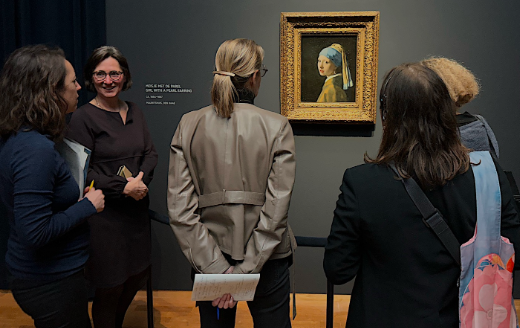Nurturing Culture and Heritage: The Comprehensive Guide to Museum Curator Jobs

Museum curators play a pivotal role in the preservation, curation, and exhibition of cultural and historical artifacts, ensuring that our collective heritage is not only protected but also presented to the public in meaningful ways. This comprehensive guide explores the multifaceted world of museum curator jobs, shedding light on their roles, responsibilities, the significance of their contributions, challenges faced, and the evolving landscape of museum curation.
Unveiling the Role of Museum Curators
1 Defining the Curatorial Role
- Guardians of Cultural Treasures: The role of curators in safeguarding and interpreting cultural and historical artifacts.
- Curatorial Specializations: Exploring the diverse areas of expertise within the field of museum curation.
2 The Curator as Storyteller
- Narrative Construction: How curators craft compelling stories through the arrangement and presentation of artifacts.
- Educational Outreach: Engaging the public through curated narratives to foster understanding and appreciation.
Responsibilities of Museum Curators
1 Collection Development and Management
- Acquisitions and Donations: Curators’ involvement in acquiring new artifacts for the museum’s collection.
- Cataloging and Documentation: The meticulous process of documenting and managing the museum’s inventory.
2 Exhibition Curation
- Conceptualization of Exhibitions: From ideation to execution, curators lead the process of creating captivating exhibitions.
- Design and Presentation: Crafting immersive and visually appealing displays to enhance the visitor experience.
3 Conservation and Preservation
- Preservation Techniques: Curators’ role in ensuring the longevity of artifacts through proper conservation methods.
- Ethical Considerations: Balancing public access with the need to preserve delicate items.
Significance of Museum Curators
1 Cultural Stewards
- Preserving Identity: How curators contribute to the safeguarding of cultural identity through artifacts.
- Cultural Diplomacy: The role of museums in fostering cross-cultural understanding and dialogue.
2 Educational Impact
- Facilitating Learning Experiences: How museum exhibitions serve as educational tools for diverse audiences.
- Community Engagement: Involving local communities in museum programs to enhance accessibility and relevance.
Challenges Faced by Museum Curators
1 Ethical Dilemmas
- Repatriation Debates: Navigating the complexities of repatriating cultural artifacts to their places of origin.
- Controversial Artifacts: Addressing the challenges posed by artifacts with sensitive or contentious histories.
2 Funding and Resource Constraints
- Financial Pressures: The impact of budget limitations on exhibition quality and collection care.
- Staffing Challenges: Managing teams with limited resources and addressing skill gaps.
Educational Paths and Professional Development
1 Academic Background
- Art History and Museum Studies: Traditional pathways for aspiring curators.
- Interdisciplinary Approaches: Embracing diverse academic backgrounds for a well-rounded curatorial perspective.
2 Continuous Learning
- Professional Development Opportunities: Staying updated on industry trends through conferences, workshops, and online courses.
- Internships and Residencies: Gaining practical experience to enhance curatorial skills.
Technology in Museum Curation
1 Digital Cataloging and Archives
- Digital Inventory Management: Leveraging technology for efficient cataloging and retrieval of artifacts.
- Virtual Archives: Creating online repositories for broader accessibility.
2 Augmented Reality (AR) and Virtual Reality (VR)
- Enhancing Visitor Experience: The integration of AR and VR technologies in museum exhibitions.
- Remote Engagement: Reaching global audiences through virtual museum experiences.
Case Studies in Museum Curation
1 The Louvre, Paris
- Iconic Exhibitions: Examining the curatorial brilliance behind some of The Louvre’s most famous displays.
- Visitor Engagement Strategies: How The Louvre attracts millions of visitors annually.
2 Smithsonian Institution, Washington, D.C.
- Diverse Collections: Managing a vast array of artifacts across different museums within the Smithsonian.
- Educational Initiatives: The Smithsonian’s role in educational outreach and community engagement.
Future Trends in Museum Curation
1 Interactive and Immersive Exhibits
- Technological Integration: The future of incorporating interactive elements for a more engaging visitor experience.
- Dynamic Exhibition Spaces: Creating flexible spaces that can adapt to evolving exhibition concepts.
2 Cultural Diversity and Inclusivity
- Representation in Exhibitions: Ensuring diverse voices and perspectives are reflected in museum displays.
- Community-Curated Exhibitions: Involving local communities in the curatorial process for increased inclusivity.
Conclusion
In conclusion, museum curators are the custodians of our shared human legacy, shaping cultural narratives, and fostering understanding across generations. As the field evolves, curators must navigate ethical challenges, leverage technological advancements, and champion inclusivity to ensure that museums remain vibrant and relevant institutions in the ever-changing landscape of cultural heritage.





